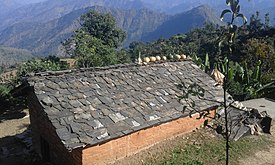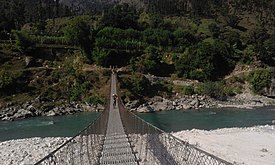Darchula District
Darchula District
दार्चुला जिल्ला | ||
|---|---|---|
Municipality List
| ||
| Government | ||
| • Type | Major highways Mahakali Highway | |
| Website | ddcdarchula | |
Darchula District (
Etymology
Darchula is made of two words "Dar" (ne:दार) and "Chula" (ne:चुला). Dar means edge (peak) in Dotyali and Chula means fire stove, literally meaning a fire stove made of three stones (or peaks of three hills/mountains). Almost all people in this place used to cook on a fire stove made of three stones. Also, there are mountain peaks here which look like a three-stone fire stove. The legend says that sage Vyasa cooked his food here on a fire stove of three peaks.[4]
History
Darchula was part of Kumaon during Katyuri rule after fall of Katyuris and disintegration of the kingdom, kumaon was divided into numerous small principalities and this region came under the Katyuri principality known as Doti Kingdom,[5][6] Gorkha annexed Doti in 1790[7] and made it part of Doti District until 1885. After 1885 it became part of Baitadi District. Baitadi and Dadeldhura had same "Bada-Hakim" (District Administrators) so those two districts used to be jointly called Baitadi-Dadeldhura district, which was formed into a proper Mahakali District after 1956. In 1956 four counties (Thums) of Baitadi were separated and made a sub-district of Mahakali district. From 1956 to 1962 the Mahakali district had three sub-districts: Dadeldhura, Bitadi and Chamba.[8][9][10]
In 1962, Chamba separately upgraded to a district and named "Darchula District".
Geography and climate

The district is surrounded by Bajhang District in the east, Baitadi District in the east and the south, Ngari Prefecture of TAR of China in the North and Pithoragarh district of India in the West.
The
The climate of the area is generally characterized by high rainfall and humidity. The climatic condition varies along with the elevation gradient. The climate of Darchula District varies widely from subtropical to alpine. In the north, most of the parts, having an alpine climate, remain under snow. In the southern part and valleys, the climate is subtropical. Mid- hills have a temperate climate. The average maximum temperature is 18.6 °C and the minimum temperature is 7.7 °C. The average rainfall is 2129mm. Most precipitation falls between May and September. About eighty percent of the total annual rainfall occurs during the monsoon season (June to September). All areas experience very high rainfall intensities, ranging between estimates of 125–350 mm (4.9–13.8 in) for a 24-hour period. Within its elevation range of 1,800 m (5,900 ft) to 6,500 m (21,300 ft), there are limited subtropical valleys in the southern margin although most of the area is ecologically temperate or highland. A cold, generally dry climate exists in the high alpine valleys just north of the southern arm of the Himalayan mountain range which cuts across the bottom of Darchula.[citation needed]
| Climate Zone[12] | Elevation Range | % of Area |
|---|---|---|
| Upper Tropical | 300 to 1,000 meters 1,000 to 3,300 ft. |
4.7% |
| Subtropical | 1,000 to 2,000 meters 3,300 to 6,600 ft. |
19.8% |
| Temperate | 2,000 to 3,000 meters 6,400 to 9,800 ft. |
22.2% |
Subalpine
|
3,000 to 4,000 meters 9,800 to 13,100 ft. |
20.5% |
Alpine
|
4,000 to 5,000 meters 13,100 to 16,400 ft. |
15.3% |
| Nival | above 5,000 meters | 17.5% |
Major rivers
Administration
Darchula District is administered by
Darchula District Court is a
| Administration | Name | Head | Website |
|---|---|---|---|
| Legislative | District Coordination Committee | Mr. Karbir Singh Karki | ddcdarchula |
| Executive | District Administration Office | Mr. Dirgha Raj Upadhyay | daodarchula |
| Judicial | District Court | Mr. Komal Prasad Aacharya | supremecourt |
Division
The district consists of nine
| SN | Local level unit | Type | Population | Area | No. of wards | Website |
|---|---|---|---|---|---|---|
| 1 | Mahakali | Urban | 21231 | 135.11 | 9 | mahakalimundarchula |
| 2 | Shailyasikhar |
Urban | 22060 | 117.81 | 9 | shailyashikharmun |
| 3 | Malikarjun | Rural | 15581 | 100.82 | 8 | malikarjunmun |
| 4 | Apihimal |
Rural | 6779 | 613.95 | 6 | apihimalmun |
| 5 | Duhun |
Rural | 10818 | 65.35 | 5 | duhunmun |
| 6 | Naugad |
Rural | 15874 | 180.27 | 6 | naugadmun |
| 7 | Marma |
Rural | 14956 | 208.06 | 6 | marmamun |
| 8 | Lekam |
Rural | 14838 | 83.98 | 6 | lekammun |
| 9 | Vyans |
Rural | 10347 | 839.26 | 6 | vyansmun |
| Darchula | District | 132484 | 2344.61 | 61 | ddcdarchula |
Former administrative divisions
Formerly, Darchula had one municipality and many VDCs. VDCs were the local administrative units for villages.
Fulfilling the requirement of the new constitution of Nepal 2015, on 10 March 2017 all VDCs were nullified and formed new units after grouping VDCs.
Constituencies
Darchula District consists 1
| Constituencies | Type | Area | MLA |
Party |
|---|---|---|---|---|
| Darchula 1 | Parliamentary | whole Darchula district | Ganesh Singh Thagunna | NCP |
| Darchula 1(A) | Provincial | Lekam, Malikarjun, Mahakali, Duhun and byans) | Gelbu Singh Bohara | NCP |
| Darchula 1(B) | Provincial | Shailyashikhar, Naugad, Marma, Apihimal | Man Bahadur Dhami | NCP |
Demographics
| Census year | Pop. | ±% p.a. | ||
|---|---|---|---|---|
| 1981 | 90,218 | — | ||
| 1991 | 101,683 | +1.20% | ||
| 2001 | 121,996 | +1.84% | ||
| 2011 | 133,274 | +0.89% | ||
| 2021 | 135,056 | +0.13% | ||
| ||||
| Source: Citypopulation[14] | ||||
At the time of the 2011 Nepal census, Darchula District had a population of 133,274.
As their first language, 96.1% spoke Doteli, 2.4% Nepali, 0.5% Lepcha, 0.3% Byangsi, 0.3% Darchuleli, 0.1% Magar and 0.2% other languages.[15]
Ethnicity/caste: 64.6% were Chhetri, 16.7% Hill Brahmin, 5.3% Kami, 4.9% Thakuri, 3.1% other Dalit, 1.3% Lohar, 1.3% Sanyasi/Dasnami, 0.7% Byasi/Sauka, 0.7% Damai/Dholi, 0.7% Sarki, 0.1% Badi, 0.1% Magar, 0.1% Tamang, 0.1% Thami and 0.2% others.[16]
Religion: 98.9% were Hindu, 0.9% Buddhist, 0.2% Prakriti and 0.1% Christian.[17]
Literacy: 65.2% could read and write, 2.4% could only read and 32.4% could neither read nor write.[18]
The number of male 63,609 and female 69,855. Decadal change 9.40%, annual growth rate 0.90%, sex ratio (males per 100 females) 91, absent (abroad) population 6,867, where number of male 5,880 and female 987. Total number of house 22,948. Total number of household 25,802. Average household size 5.17. Population density 57 km2 (22 sq mi). The town has an Indian counterpart to its northwest, named Dharchula. The split between the two towns is just virtual as the traditions, culture, and lifestyle of the people living across both the regions are quite similar.[citation needed]
More than 56,000 people live in 8,989 households. About 58.4 percent of the population falls below the poverty line.[1]
Economic development
Darchula is one of the least developed districts of the country. The major socioeconomic indicator of Darchula District is still very poor. Life expectancy of these people was about 52 in 1996. About 89.90% of the total population depends upon agriculture. Substance agriculture, lack of basic infrastructure, difficult geophysical condition, traditional agricultural practice, low literacy rate and population growth are the root causes for deeply rooted poverty.[1]
Trade and business
Trade is one of the most important means of livelihood. Every year, people from the hills come with NTFP, ghee, and herbs to sell. Agriculture related commodities are sold in local bazaars (markets). People of Byans, Rapla go to Tibet to fill their needs for clothes and other commodities. Local carpets and wool products, handmade clothes, and NTFP bring in huge amounts of money to the VDCs. However, each and every respondent indicated that their income is invested in domestic use.
Tourism
Api Nampa Conservation Area is a famous gateway to Kailash Mansarobar's holy region located in Tibet. Many pilgrims pass through this Conservation Area to get to Kailash Pravat. Not only Nepalese but also foreigners visit Api Nampa Conservation Area to acquire satisfaction, spirituality and the boons of nature. The first European, A. H. Savage Landor entered Nampa valley in 1899 and explored the glacier system. He travelled across the Tinkar valley and entered Tibet via the Lipu pass. In 1905, Dr. Longstaff visited this region. Then Swiss geologists A. Heim and A. Gansser visited the Api Himal area in 1936. The elevation of Api Himal at the top is calculated to be 23,399 ft. John Tyson and W. H. Murray explored this region in 1953. An Api group has been created to lure tourists wanting to see the geological features blending with nature and other natural assets. Sauka culture is also an attraction for tourist. Api Himal can be visited by going via Darchula Bazar, Huti, Sunsera, Rapla to base camp. It takes five days to reach there or travelers may go via Bitule, Makari Gad, Ghusa Village, Domilla, to Lolu at the base camp. Panoramic views of Himalayas are created by several peaks like Nampa, Jethi Bahurani and others.[citation needed]
Media/radio partners
To Promote local culture there are few FM radio stations: Radio Samad FM 102.6 MHz,[19] Radio Naya Nepal FM 104.5 MHz,[20] Darchula FM, which are Community radio Stations.
Education
Colleges and schools
- Darchula Multiple Campus
- Gokuleshwar Higher Secondary School
- Himalaya Higher Secondary School
- Gokuleswar Multiple Campus
- Sri Krishna Snatak Campus
- Rastriya Campus
- Shankarpur Higher Secondary School
- Latinath Higher Secondary School
- Srikrishana Higher Secondary School
- Rastiya Higher Secondary School
- Latinatha Higher Secondary School
- Hunainath Secondary School Baaj (Mahara Village)
- Hunainath Higher Secondary School
- Janabikasa Higher Secondary School
- Ganesh Binayak Higher Secondary School
- Malikarjun Higher Secondary School
- Krishana Higher Secondary School
- Sarswati Higher Secondary School
- Gurilamandu Higher Secondary School
- Galainath Higher Secondary School
- Satya Parkash Higher Secondary School
- Sri Krishana Higher Secondary School
- Apinampa Campus
Gallery
-
Api mountain
-
House in Lekam Gaupalika ward no. 02
-
Houses in Lekam Gaupalika Kuni
-
Temple of God Hunainath at Lekam Kuni
-
Suspended Trail bridge over the Chaulani river
References
- ^ a b c d "National Population and Housing Census 2011(National Report)" (PDF). Central Bureau of Statistics. Government of Nepal. November 2012. Archived from the original (PDF) on 18 April 2013. Retrieved 1 November 2012.
- ^ "NepalMap profile: Darchula".
- ^ http://www.npc.gov.np/human_development_indicators_by_district/
- ^ "दार्चुला जिल्लाको संक्षिप्त परिचय". ddcdarchula.gov.np (in Nepali). DDC Darchula. n.d. Retrieved 11 February 2020.
- OCLC 899733017.
- OCLC 833063116.
- ^ "M. Gaborieau on 7 Bharats recorded in Nepal (1969)". n.d. Retrieved 18 February 2020.
- ^ "Government of Nepal Act 1948" (PDF).
- ^ "प्रशासकीय पुनर्गठन समिति (बुच कमिशन) को प्रतिवेदन, २००९" (PDF).
- ^ "नेपालको जिल्ला प्रशासन पुनर्गठनको रिपोर्ट, २०१३" (PDF).
- ^ "Himalaya". yetitrailadventure.com. n.d. Retrieved 11 February 2020.[permanent dead link]
- ^
The Map of Potential Vegetation of Nepal – a forestry/agroecological/biodiversity classification system (PDF), Forest & Landscape Development and Environment Series 2-2005 and CFC-TIS Document Series No.110., 2005, ISBN 87-7903-210-9, retrieved 22 November 2013
- ^ "स्थानिय तह" (in Nepali). Ministry of Federal Affairs and General Administration. Retrieved 1 September 2018.
- ^ "NEPAL: Administrative Division". www.citypopulation.de.
- ^ NepalMap Language [1]
- ^ NepalMap Caste [2]
- ^ NepalMap Religion [3]
- ^ NepalMap Literacy [4]
- ^ "50.Radio Samad FM 102.6 MHz".
- ^ "Radio Naya Nepal FM 104.5 MHz".








